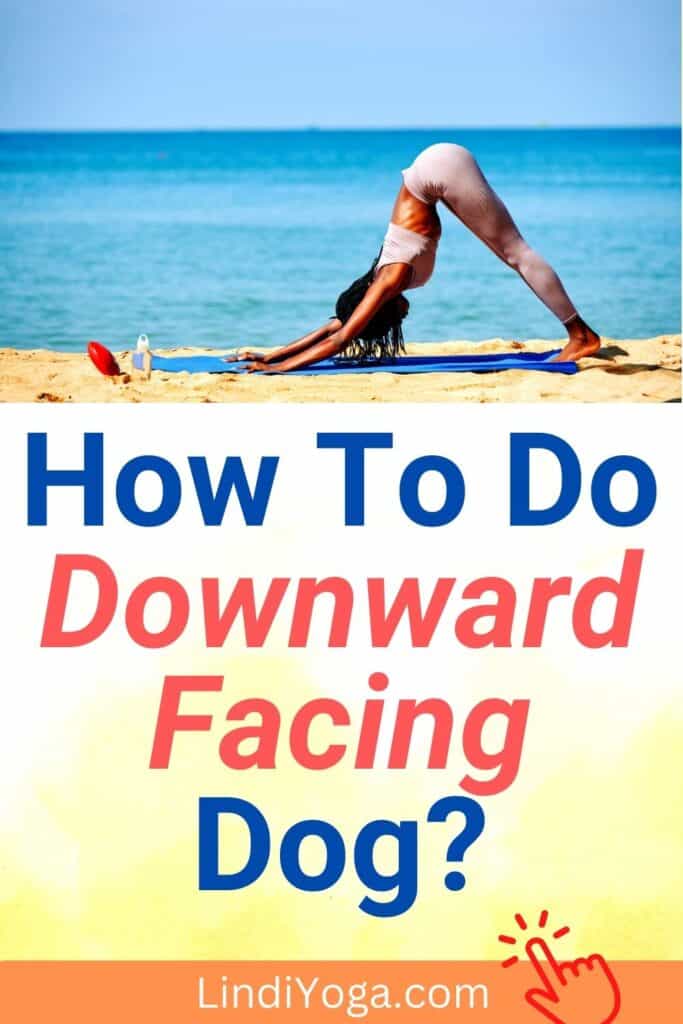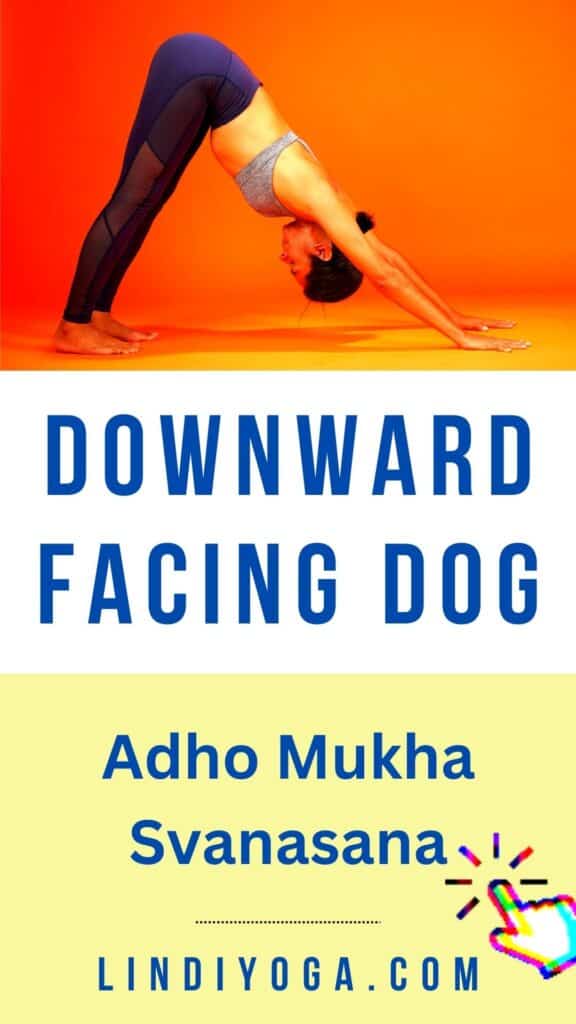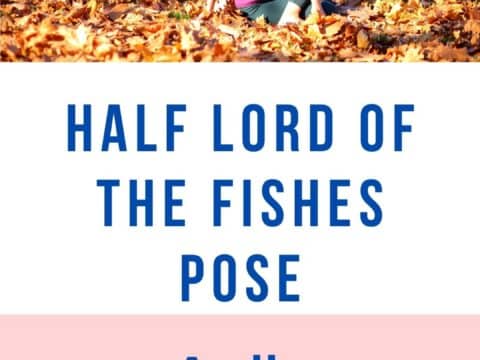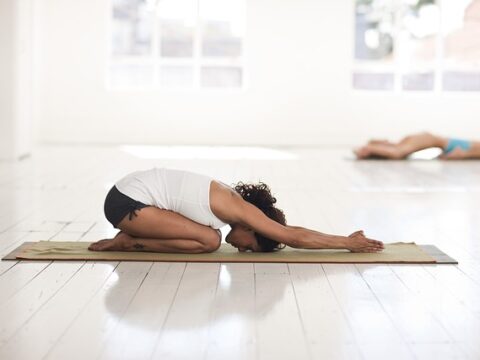Have you ever wondered how to master the perfect Downward-Facing Dog (Adho Mukha Svanasana)? According to recent surveys, over 50% of people have tried this popular yoga pose at least once.
Whether you’re a beginner or an experienced yogi looking for improvement, mastering the art of Adho Mukha Svanasana is essential in creating a balanced and healthy lifestyle.
In this article, we will discuss ways to achieve that perfect downward dog so that you can experience all the benefits it has to offer!
Are you ready? Let’s get into it! Despite its intimidating appearance, achieving the right form for downward-facing dog isn’t as difficult as it looks; with simple steps and practice anyone can learn how to do it correctly.
It’s important to approach each step mindfully and take your time while getting used to the posture. With dedication and patience, even beginners can reap the rewards of proper alignment during their practice.
Step-By-Step Instructions
Downward facing dog, also known as Adho Mukha Svanasana, is an inverted pose that helps to stretch the entire body. Here’s how to perform this pose:
- Begin on your hands and knees, with your wrists aligned under your shoulders and your knees under your hips.
- Inhale and lift your hips towards the ceiling, bringing your heels towards the ground.
- Straighten your legs, keeping your knees slightly bent if necessary.
- Lift your head and chest, bringing your gaze towards your legs.
- Hold the pose for a few deep breaths, then release and return to a tabletop position.
With these tips in mind, be sure to move slowly when practicing Adho Mukha Svanasana in order to build strength safely—allowing yourself enough time to adjust body for optimal positioning before moving onto next sequence.
Understanding how to properly do Downward Facing Dog Poses helps set foundation for advanced poses down road—and makes journey along way more enjoyable!
Benefits Of Adho Mukha Svanasana
Adho Mukha Svanasana, or downward-facing dog pose, is a powerful posture with many physical and mental benefits. This classic yoga asana stretches the entire body while building strength in the arms, legs and core muscles.
The downward motion of the spine lengthens it and increases flexibility, improving posture over time. It also helps to improve circulation throughout the body which can help reduce fatigue.
As an added bonus, this pose has been known to reduce stress levels due to its calming effect on both mind and body.
The pose itself not only provides numerous physical advantages but can even provide emotional relief for those dealing with depression or anxiety.
By focusing on breath control and maintaining proper alignment during practice, practitioners are able to find peace of mind that will last through their day-to-day lives.
Not to mention, mastering Adho Mukha Svanasana requires effort and dedication—the perfect remedy for anyone feeling sluggish or bored! With all these amazing benefits at your fingertips, you’re sure to feel renewed after each session of downward-facing dog.
Ready to start reaping the rewards? Preparing for Adho Mukha Svanasana is easy; let’s get started!
Preparing For The Pose
Did you know that Adho Mukha Svanasana is one of the most popular poses in yoga? Whether you’re a beginner or an experienced yogi, it’s important to start by properly preparing your body for this pose.
In this section, we’ll discuss how to set up and position yourself before attempting the pose.
Warm-up exercises are essential prior to performing any posture. This helps to align and open up the body while also improving flexibility and range of motion.
Start with basic stretches such as neck rolls, shoulder circles, and torso twists. These movements offer a great way to warm up your spine and prepare your core muscles for downward-facing dog.
Next, focus on lengthening your hamstrings by doing some forward folds like seated straddle stretch or standing wide leg forward fold. Make sure not to lock out your knees when stretching so you can get maximum benefit from these warm-ups without risking injury.
Finally, practice activating your abdominal muscles with planks and other core strengthening exercises – these will help support your lower back during the pose.
By taking time to properly prepare for downward-facing dog you ensure that you’re able to move more deeply into the pose while minimizing potential risks of injury. Now let’s move onto step-by-step instructions on how to do adho mukha svanasana correctly!
Common Mistakes To Avoid
The downward facing dog pose is a great way to stretch and strengthen the body, but it’s important to make sure you’re doing it correctly. Otherwise, you could be setting yourself up for an injury or alignment issues. Here are some common mistakes to avoid when performing this asana.
First of all, many people have the wrong placement for their hands and feet. Make sure your wrists are directly under your shoulders and that your knees are right below your hips. Improper breathing can also lead to strain on the neck, so try focusing on deep inhales and exhales while in this position.
Another mistake beginners make is overstretching their hamstrings. If they feel like they need more of a stretch here, then they should come out of the pose slightly until they find a comfortable level of intensity.
Finally, don’t forget to keep checking if your form is correct throughout each practice session – otherwise you might end up straining something without realizing it!
With these tips in mind, you’ll be able to properly perform adho mukha svanasana without any major injuries or misalignments – now let’s look at how we can modify and alter this beloved yoga posture for different levels of experience!

Modifications And Alternatives
Downward facing dog is one of the foundational poses in many styles of yoga. It can be very challenging to do correctly, but there are modifications and alternatives available for all levels of practitioners.
Here are a few ideas:
Modified Downward Dog:
Pull the knees off the ground slightly so that your bodyweight is more evenly distributed across your hands and feet.
Place a pillow or block under your head and chest for extra support.
Beginner Modifications:
Bend the knees slightly when coming into Adho Mukha Svanasana. This will help make it easier to keep good alignment as you practice.
Do not go too deep into this pose if it causes any pain or discomfort. Back out until you find what feels right for you.
Chair Modifications:
Sit on the edge of a chair with both feet flat on the floor, shoulder width apart, facing forward with arms extended overhead and fingers interlaced behind your head.
Keep your legs straight while engaging your abdominal muscles to lift up through your spine like an upside down U shape (like a modified downward dog). Hold this position for 10 breaths before releasing back down onto the chair.
Wall Modifications:
Stand about two arm lengths away from a wall with toes pointed forward and heels pressing against it lightly.
Reach up toward the ceiling with both arms extended above your head, palms facing inward towards each other, then slowly bend over from hips maintaining length in torso as you bring elbows to rest gently on wall surface at either side of head. Rest here for five breaths before returning upright again.
Legs Up The Wall:
Lie on your back near a wall and swing legs up onto wall keeping hips close to baseboard by placing pillows underneath them if necessary; press soles together, relax shoulders away from ears, breath deeply into lower belly area for 5 minutes or longer if desired – this variation helps open hip flexors while stretching hamstrings simultaneously!
With regular practice these areas become softer allowing practitioner better access into traditional form of Adho Mukha Svanasana later on down their path.
No matter which version works best for you, taking time to explore different variations will help cultivate greater awareness around how each posture affects our bodies differently—something that’s invaluable knowledge when striving towards safe yoga practice.
As we take mindful steps towards deepening our understanding of postures such as Adho Mukha Svanasana.
We create space within us where transformation takes place naturally over time without feeling rushed or forced into anything beyond what feels comfortable in present moment experience and props and accessories can facilitate further refinement along way!
Props And Accessories
Adding props and accessories to your practice of Adho Mukha Svanasana can help you achieve the pose with more ease. Yoga blocks, straps, mats, bolsters, and blankets are all useful tools for making downward-facing dog more comfortable.
Blocks provide a stable base that helps take pressure off your hands and feet while in the pose. Straps allow you to maintain proper form without having to worry about reaching too far forward or back.
A yoga mat will cushion your body from hard surfaces so you can focus on alignment instead of pain. Bolsters offer support under your legs if needed, and blankets give extra warmth when practicing in cooler temperatures.
With these items at hand, it’s easy to adjust any part of the posture to accommodate any limitations or preferences you may have! Safety considerations should always be taken into account prior to attempting this asana; see the next section for details.
Safety Considerations
When practicing Adho Mukha Svanasana, safety considerations should always be kept in mind. Practicing with proper alignment and form can help to prevent injury.
For beginners, having a qualified yoga teacher present is essential for learning the correct placement of the body in this pose. It’s important to keep the shoulders aligned with the wrists while keeping the arms straight and engaging the core muscles throughout.
Additionally, modifications such as placing blocks below the hands or using a wall for support may be helpful at first. Seniors should also take precautions and modify their practice if necessary by making sure they have enough space and support around them before attempting this pose.
By following these simple tips, one can enjoy all of the benefits of downward-facing dog without risking injury. With the right preparation and attention to detail, practitioners will find that transitioning into and staying in this pose becomes easier over time.
Staying In The Pose
Now that you understand the safety considerations for downward facing dog, it’s time to learn how to stay in the pose. To begin, stand with your feet hip-width apart and fold forward from your hips until your hands reach the mat.
Your arms should be perpendicular to the floor and your fingers spread wide. From here, press both hands into the ground as you extend your spine towards the ceiling.
As you do this, engage your legs by pressing down firmly through all four corners of each foot. Hold this posture for a few breaths and focus on keeping your chest lifted while sinking deeper into the stretch.
Once comfortable in adho mukha svanasana, remain in place and feel out any areas that may need further stretching or release. If there are tight spots, take a few moments to really explore them before continuing onward.
You can also use props such as blocks or straps if needed to help you hold the pose longer without strain. Remember that even though staying in one pose can be challenging at times, it is essential for deepening practice and gaining strength over time.
So push yourself gently but never force anything – instead let go of expectations and simply enjoy each moment fully as you extend into new realms!
Sequencing With Other Poses
Downward-facing dog is a popular pose in yoga classes, as it provides an excellent opportunity to stretch and balance the body. To take full advantage of this pose, it should be thoughtfully sequenced with other poses for maximum benefit.
A great way to do this is by incorporating sun salutations into your practice. This helps warm up the muscles before holding downward-facing dog for longer periods of time.
Additionally, standing poses are often used to further open up the legs and hips prior to entering into Adho Mukha Svanasana.
Seated poses such as pigeon can also provide an effective preparation, while arm balances can help build strength and flexibility when transitioning from downward-facing dog to backbends or other more challenging postures.
Ultimately, sequencing appropriate poses together will allow you to experience greater benefits from each posture, including those deriving from down facing dog itself!
Breathing Exercises For Downward Facing Dog
Adho Mukha Svanasana pose, is one of the most popular poses in yoga. It stretches and strengthens your entire body while bringing a sense of grounding and calming energy. To take this pose to the next level, it’s important to incorporate breathing exercises into your practice.
Yoga pranayama (breath work) can be used to deepen the effects of any yoga posture. When practicing Adho Mukha Svanasana, start by focusing on equalizing your inhalations and exhalations for a few breaths.
This helps you stay present with each breath and brings awareness to where you’re holding tension in your body. After that, try adding alternate nostril breathing to further activate both sides of the brain and balance out any energetic imbalances that may arise during the pose.
Yoga Nidra Practices For Adho Mukha Svanasana
Yoga Nidra is an incredibly powerful and restorative practice that can be used to enhance the physical benefits of downward-facing dog. By focusing on breathwork, visualization, and body awareness during this pose, practitioners are able to reach a deeper level of relaxation.
This helps cultivate energy within the body while allowing for greater focus and presence.
When practicing Yoga Nidra with Adho Mukha Svanasana, it’s important to start slowly by gently stretching out your arms and legs before settling into the pose.
Once you feel comfortable in the posture, begin focusing on each part of your body from head to toe while inhaling through your nose and exhaling through your mouth.
Visualize yourself becoming one with the ground beneath you as if you were melting into its support. As thoughts arise, simply observe them without judgment or attachment until they pass away.
Lastly, allow any sensations or emotions that come up to move freely throughout your body without clinging onto them; instead let go of any expectations or attachments so that you can fully relax into downward-facing dog pose.
By connecting with stillness and silence within yourself through these mindful practices, we open ourselves up to new possibilities both physically and mentally. Moving forward then becomes effortless as we regain our sense of connection with nature around us.
Closing Reflections
The closing reflections provide us with an opportunity to create space for mindful meditation and enter into a meditative state in which we can observe the effects this practice has had on our body, mind, and spirit.
We can begin by focusing attention inwardly and looking for any sensations that are present within ourselves. This could be physical sensations or emotions that have arisen as a result of practicing Adho Mukha Svanasana.
Taking note of these experiences allows us to gain insight into how the pose affects us physically, mentally, emotionally, and spiritually. Becoming aware of these subtle energies helps bring clarity to what aspects we may need to focus more on while deepening our practice awareness.
Once we’ve identified the changes brought about through our practice of downward-facing dog, it’s important to recognize them before bringing closure to the session so that they become part of our conscious memory.
It’s also essential to appreciate all these new insights gained throughout the experience – because when we do so, it further strengthens our understanding of yoga nidra practices in general.
Reflecting upon each step taken during this process brings greater self-awareness and encourages deeper exploration next time round.
As we complete this exercise, let us remain rooted in gratitude for having gone through such an enlightening experience today – one which will surely help guide many future sessions ahead!

Frequently Asked Questions
How Long Should I Stay In The Pose?
When it comes to staying in the pose of Adho Mukha Svanasana, how long you remain there depends on your yoga practice.
It’s important to understand that the amount of time spent in a particular pose is best determined by you and your body. That being said, here are some tips for determining how long to stay in this classic asana:
- Listen to Your Body: If something hurts or feels uncomfortable, don’t push yourself beyond what your body can handle.
- Take Breaks When Needed: Make sure to take breaks when needed so that you don’t overexert yourself with too much intensity for too long.
- Increase Length Gradually: Start off slowly and gradually increase the length of time spent in the pose over time as you become more comfortable with it.
- Modify As Necessary: Consider modifying the posture if certain aspects feel like they’re out of reach – even just small modifications can make all the difference!
By following these guidelines, everyone can find their own unique way of practicing Adho Mukha Svanasana safely and effectively while increasing their yoga knowledge along the way!
This timeless pose offers an abundance of benefits both physically and mentally – from strengthening muscles and improving flexibility to cultivating mindfulness and calming anxieties – so give yourself permission to explore its depths at whatever pace works best for you.
What Type Of Clothing Should I Wear To Practice This Pose?
When it comes to performing Downward-Facing Dog (Adho Mukha Svanasana), the type of clothing you wear can make a big difference.
Whether you’re practicing yoga, hitting the gym, or simply stretching at home, wearing comfortable and flexible activewear is key for optimal performance and comfortability. Here are some things to keep in mind when picking out your yoga wear:
- Look for fabrics that bend and stretch easily – think spandex, lycra, nylon and polyester blends
- Choose clothes that fit comfortably without being too tight or too loose
- Opt for bright colors and patterns if desired to add style to your practice
We all know how important it is to be comfortable while exercising, so why not take this one step further with clothing specifically designed for activities like yoga?
Brands like Lululemon have crafted their pieces using lightweight materials such as mesh fabric which provide excellent breathability during even the most intense workouts.
Furthermore, these clothes allow full range of motion without compromising on quality – perfect for getting into those tricky poses! Gym clothes are also great options as they often come equipped with moisture wicking technology so you stay dry throughout your entire session.
No matter what type of clothing you choose, always prioritize comfort first. This doesn’t mean sacrificing fashion – just look for items made from flexible fabrics that still look good.
With the right wardrobe essentials in tow, you’ll be able to flow through each pose with ease knowing you’re feeling your best in every moment.
Can I Practice Downward Facing Dog With An Existing Injury?
Practicing yoga has become increasingly popular as a form of exercise and meditation. Despite the many benefits, practicing some poses can be challenging for those with existing injuries or conditions. Downward Facing Dog is one such pose that requires special attention when it comes to injury.
When it comes to any type of practice, modifications are key in order to ensure safety while still reaping the full benefits of a particular technique.
For example, someone with an injury may need to modify their downward-facing dog by slightly shifting their weight off of certain areas or adjusting the range of motion that they would normally use in this pose.
In addition, props such as blocks and straps can be used to support the body and reduce strain on injured areas.
The important thing to remember when practicing downward-facing dog with an existing injury is that everyone’s experience will differ based on severity, type and location of the injury.
Therefore, it is essential to work slowly and within your own limits; listen to your body carefully – if something doesn’t feel right then stop immediately:
- Pay close attention during practice and notice how you are feeling before attempting the pose.
- Take breaks throughout practice so you don’t overwork yourself or put too much strain on specific parts of your body.
- Consider using props such as blocks or bolsters which can help provide extra support where needed.
- Always consult with a qualified medical professional before engaging in any physical activity related to managing an existing injury/condition.
In short, while downward-facing dog is a great pose for stretching out tight muscles and improving posture, caution should always be taken when dealing with pre-existing injuries or conditions – seeking advice from professionals and doctors who understand these issues is highly recommended!
How Often Should I Practice This Pose?
When it comes to practicing Adho Mukha Svanasana, how often should you do it? This is an important question for any yogi looking to include this pose in their practice. Knowing the frequency of your poses can help you reach maximum benefits while avoiding injury and overuse.
One factor to consider when deciding on a frequency is your current level of experience with downward-facing dog.
If you’re new to yoga and just beginning the pose, start out by doing it once per day. As your body gets more accustomed to the position, gradually increase the number of times you do the pose each day.
You may even find that some days are better suited than others for more frequent practice. For example, if your body feels extra tight one day, try doing two sessions of downward dog instead of one that day to loosen up those muscles.
On the other hand, experienced yogis might want to take a different approach. Since downward dog has become part of their regular routine already, they could look into incorporating variations and modifications into the pose so that their bodies don’t get too used to it.
This way they can continue getting all its benefits without risking overusing certain muscle groups or joints. Additionally, experts suggest taking at least one rest day between practices as well as listening closely to what our bodies need: sometimes less really is more!
In sum, finding an appropriate frequency for practicing downward-facing dog will depend on individual preferences and goals; however no matter where you’re at with your practice there’s always something new to learn about the pose and ways we can make sure we’re reaping its full potential safely and effectively.
Conclusion
I hope this article has helped you understand how to do downward facing dog. With practice and dedication, you can reap the many benefits of this pose for your physical and mental health.
Remember that no two people are alike – some may find it easier to stay in the posture than others. It’s important to take things at your own pace, listen to your body, and adjust accordingly.
Wear clothing that won’t restrict your movements while practicing this asana; if you have an existing injury, consult a medical professional before attempting any yoga poses.
Ultimately, regular practice of downward facing dog is key to seeing results and feeling its effects on my body and mind. So go ahead and give it a shot! I’m sure that with persistence and patience, I’ll be able to master this beautiful pose soon enough.




